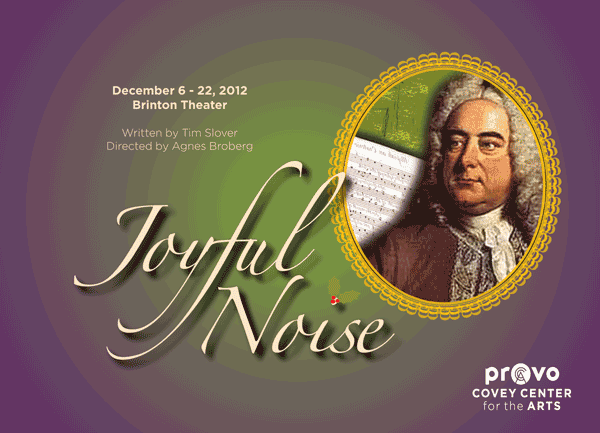SALT LAKE CITY — Westminster College’s production of Rumors starts off with a bang—literally. A gunshot in the dark launches the audience into the world of Charlie and Myra Brock’s tenth wedding anniversary party, and nothing is going as planned. The hostess, Myra, is missing, the “help” has disappeared, and the unseen Charlie has shot himself in the earlobe. The first guests on the scene, Ken and Chris Gorman (the wonderfully frenetic Michael Calacino and lovably manic Ann Louise Brings), do their best damage control in hopes of protecting their friend from an attempted suicide scandal—a friend that happens to be the Deputy Mayor of New York.
Neil Simon wrote the play in 1988 at the height of the 80’s “greed is good” social mantra. The affluence of the characters involved is supposed to heighten the stakes of what happens if Charlie’s mishap is discovered, requiring elaborate lies to cover up the truth leading to absolute absurdity. I think originally Simon meant his text as social commentary, and while there are moments within the text that brutally show the shallowness of those with lots of money, the characters are far more human than the cartoonish situation the author has placed them in.
Attempted social commentary aside, the first act is the sharp, clever, door-slamming spectacle a good farce deserves. As additional couples arrive, the lies expand and gossip is passed in a whimsical adult game of telephone. Allison Lente as Claire Ganz shares and cajoles information with cool relish while Nikola Muckajev, playing her accountant husband Lenny, is forced to deal with whiplash from a pre-party car accident as he reels in horror at the “filth” people say about others. Kelley Davis is charming a Cookie Cusack, a cooking show host with ongoing back spasms, who constantly bandies endearments with her analyst husband, Ernie (Niklaas Duncan). Ernie is almost Fruedian in his appearance and indeterminate Germanic accent. I’m not sure if the accent is in the script, but it was an interesting choice and Duncan pulls it off with minimal muddling of his words.
Cassie (Hailey Henderson) and Glenn Cooper (Wyatt McNeil) are the last guests to arrive and have their own private tempest brewing. McNeil is a perfect tanned-for-TV up-and-coming politician unable to handle his mercurial wife. Henderson at first appeared unsure in her heels and dress, but rapidly gained her footing. The whole ensemble handily delivers the physical comedy required by the script. The actors were effective as they took turns sweeping, bounding, running, and even crawling across the set. The dialogue is crisp and clear—essential for farce—and the timing of every bit was immaculate.
For all the tenacity of the actors, they couldn’t quite beat the energy lag of the second act. The first act ends in utter chaos and the second act can’t quite recapture that liveliness. The story is demanding to be resolved, but the actors seemed to be stuck a little in a murky script, unsure of how it should resolve. If that flying-by-the-seat-of-your-pants feeling was intentional, then I rightfully applaud director Jared Larkin for crafting that evolving-by-the-minute magic. Another gunshot, temporary deafness, various injuries and confessions keep the action moving well, but not entirely with a point. Toward the end of the play, two police officers show up and try to make sense of the whole thing. Joseph Paul Branca as Officer Welch and Shianne Gray as Officer Pudney were both sturdy as the everyman characters forcing the resolution, although an obviously fake pot-belly on Branca was mildly distracting.
As an ensemble, the performers were admirable. The set, designed by Nina Vought, is a perfect environment for the play, communicating wealth and the pastel-colored interior design of John Hugh’s movies (curving staircase leading to a believable second level, leaded glass windows flanking the front door, a chandelier, and plenty of doors to slam). Spencer Brown’s lighting was airy and film-like with a clever effect for cars coming up a driveway. The visual style of the play seemed slightly diffused, like when you watch old video tape, and that helped solidify the time period.
The costumes (also by Vought) were firmly based on truth of 1980’s “high” fashion: men in pleat-front suit pants and muted-pattern vests, women in not-quite neon frills and ruffles. The ’80s were not kind fashion-wise, but the busy-ness of the garments helps communicate the materialism of the time. Brings, in a dress the script claims was $1200, occasionally unintentionally steals focus simply because her entire upper half is covered in hot-pink sequins. Lente glides across stage in a powder blue number that would be unkind to someone less poised, while Davis sports a “Russian” folk costume in reds and golds. Henderson’s aforementioned initial uncertainty may have been due to the cut of her purple flocked dress yet, by act two, she knows how to work it effectively enough to successfully vamp it up. Vought costume designs are engaging, but I personally felt that mixed with the extreme stereotypical hairstyles of the era, the women’s costumes tried to force additional absurdity where none was needed.
Overall, Rumors is a fun and interesting production. There is some language that makes it a PG-13 outing, but I congratulate the cast for not letting it sound forced or unnatural (and for not shrinking away from it). The opening night performance was polished and, while I could have done without the super-80’s dance move curtain call, you could tell the performers were having a blast- and so was the audience.




